Solar power plant on the house 200 m2 do it yourself
Often in the network jump messages about the struggle for the environment, the development of alternative energy sources. Sometimes they even make reports on how a solar power plant was made in an abandoned village, so that local residents could enjoy the benefits of civilization not 2-3 hours a day while the generator is working, but constantly. But all this is somehow far from our life, so I decided to show and tell by my example how the solar power station works and how it works for a private house. I'll tell you about all the stages: from the idea to the inclusion of all devices, as well as share the operating experience. The article will turn out rather big, so who does not like a lot of letters can watch the video. There I tried to tell the same thing, but it will be seen how I collect all this myself.
Baseline: a private house with an area of about 200 m2 is connected to the grid. Three-phase input, with a total power of 15 kW. The house has a standard set of electrical appliances: refrigerator, televisions, computers, washing and dishwashers, and so on. The stability of the power grid is no different: the record I recorded was a shutdown of 6 days in a row for a period of 2 to 8 hours.
What I want to get: forget about the power outages and use electricity, no matter what.
')
What bonuses can be: Make the most of the sun's energy, so that the house prioritizes on solar energy, and the shortage gets from the network. As a bonus, after the adoption of the law on the sale of electricity by individuals to the network, begin to offset part of their costs by selling surplus generation to the general electricity grid.
There are always at least two ways to solve any problem: to learn by yourself or to entrust the solution of a problem to someone else. The first option involves the study of theoretical materials, reading forums, communication with the owners of solar power plants, the fight against internal toad and, finally, the purchase of equipment, and after - installation. The second option is to call a specialized company, where they will ask many questions, pick up and sell the necessary equipment, or they can install it for some money. I decided to combine these two ways. Partly because it is interesting to me, and partly in order not to run into sellers who just need to earn money by selling not exactly what I need. Now it's time for a theory to understand how I made the choice.
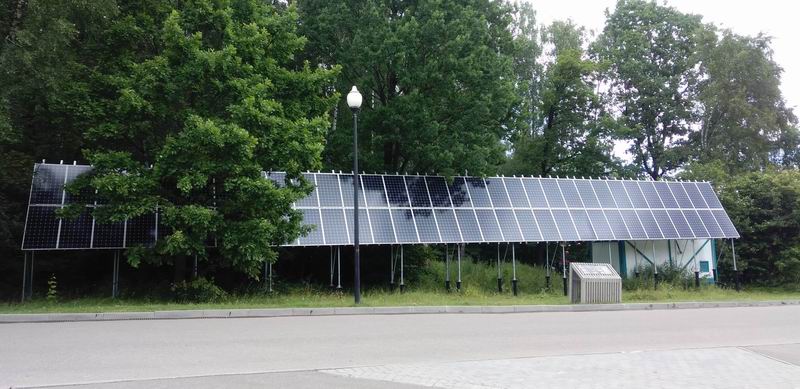
In the photo is an example of the "development" of money for the construction of a solar power station. Notice that the solar panels are installed behind the tree - thus, the light does not fall on them, and they simply do not work.
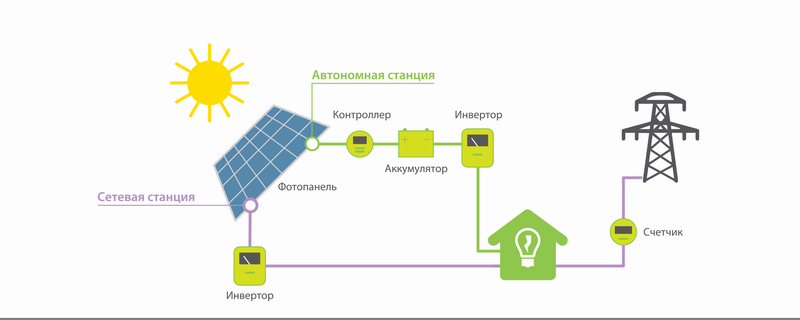
Immediately, I will say that I will not talk about industrial solutions and not about super-power systems, but about the usual consumer solar power plant for a small house. I am not an oligarch to waste money, but I adhere to the principle of reasonableness. That is, I don’t want to heat the pool with “solar” electricity or charge an electric car, which I don’t have, but I want all the appliances in my house to work constantly, without looking at the electrical network.
Now I will tell about the types of solar power plants for a private house. By and large, there are only three of them, but there are variations. I will be located on the growth of the cost of each system.
Network Solar Power Station - this type of power plant combines low cost and maximum ease of operation. It consists of only two elements: solar panels and a power inverter. Electricity from solar panels is directly converted to 220V / 380V in the house and consumed by household energy systems. But there is a significant drawback: the backbone network is necessary for the operation of the SSE. In case of disconnection of the external power supply network, the solar panels will turn into a “pumpkin” and cease to generate electricity, since for the operation of the mains inverter, the reference network is needed, that is, the very presence of electricity. In addition, with the existing power grid infrastructure, the operation of a power inverter is not very profitable. Example: you have a solar power station of 3 kW, and the house consumes 1 kW. The surplus will “flow” into the network, and conventional meters consider energy “by module”, that is, the meter delivered to the network will calculate how consumed, and you still have to pay for it. Here the logical question is: where to put the extra energy and how to avoid it? We turn to the second type of solar power plants.
Hybrid Solar Power Station - this type of power plant combines the advantages of a networked and autonomous power station. It consists of 4 elements: solar panels, solar controller, batteries and a hybrid inverter. The basis of everything is a hybrid inverter, which is capable of mixing energy from solar panels into the energy consumed from an external network. Moreover, good inverters have the ability to customize the prioritization of energy consumed. Ideally, the house should first consume energy from solar panels and only with its lack, get from the external network. In the event of the disappearance of the external network, the inverter goes into autonomous operation and uses the energy from solar panels and the energy stored in the batteries. Thus, even if the electricity is disconnected for a long time and it is a cloudy day (or the electricity is disconnected at night), everything in the house will function. But what to do if there is no electricity at all, but somehow you have to live? Here I turn to the third type of power station.
Autonomous Solar Power Station - this type of power plant allows you to live completely independently of external power grids. It may include more than 4 standard elements: solar panels, solar controller, battery, inverter.
In addition to this, and sometimes instead of solar panels, a Hydropower Plant of low power, a wind power plant, or a generator (diesel, gas or petrol) can be installed. As a rule, there is a generator at such facilities, since there may be no sun and wind, and the energy supply in the batteries is not infinite - in this case, the generator starts and provides energy to the whole object, simultaneously charging the battery. Such a power plant is easily transformed into a hybrid one, when an external power supply is connected, if the inverter has these functions. The main difference between an autonomous inverter and a hybrid one is that it does not know how to mix energy from solar panels to energy from an external network. At the same time, the hybrid inverter, on the contrary, can work as a stand-alone one if the external network is disconnected. As a rule, hybrid inverters are commensurate in price with fully autonomous, and if they are different, then they are insignificant.
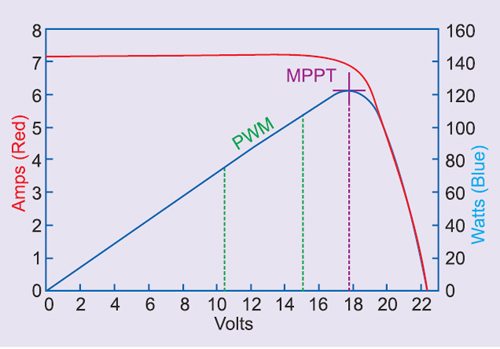
In all types of solar power plants there is a solar controller. Even in the network of solar power it is, just part of the network inverter. Yes, and many hybrid inverters are available with solar controllers on board. What is it and what is it for? I will talk about a hybrid and autonomous solar power station, since this is just my case, and I can familiarize myself with the network inverter device in the comments if there are requests in the comments.
The solar controller is a device that converts the energy received from solar panels into energy that is digested by the inverter. For example, solar panels are manufactured with a voltage of a multiple of 12V. And batteries are made in multiples of 12V, so it has become a tradition. Simple 1-2 kW power systems operate on 12V. 2-3 kW productive systems are already functioning from 24V, and powerful systems of 4-5 kW and more operate on 48V. Now I will consider only "home" systems, because I know that there are inverters operating at voltages of several hundred volts, but for the house it is already dangerous.
So, let's say we have a 48V system and 36V solar panels (the panel is assembled in multiples of 3x12V). How to get the required 48V for the inverter? Of course, a 48V battery is connected to the inverter, and a solar controller is connected to these batteries on one side and solar panels on the other. Solar panels are going to deliberately more voltage to be able to charge the battery. The solar controller, receiving a deliberately greater voltage from the solar panels, transforms this voltage to the desired value and transmits it to the battery. It is oversimplified. There are controllers that can reduce from 150-200 V from solar panels to 12 V batteries, but here very large currents flow and the controller works with worse efficiency. The ideal case, when the voltage from the solar panels is twice the voltage on the battery.
There are two types of solar controllers: PWM (PWM - Pulse Width Modulation) and MPPT (Maximum Power Point Tracking). The principal difference between them is that the PWM controller can only work with panel assemblies that do not exceed the battery voltage. MPPT - the controller can operate with a noticeable overvoltage relative to the battery. In addition, MPPT controllers have significantly greater efficiency, but also cost more.
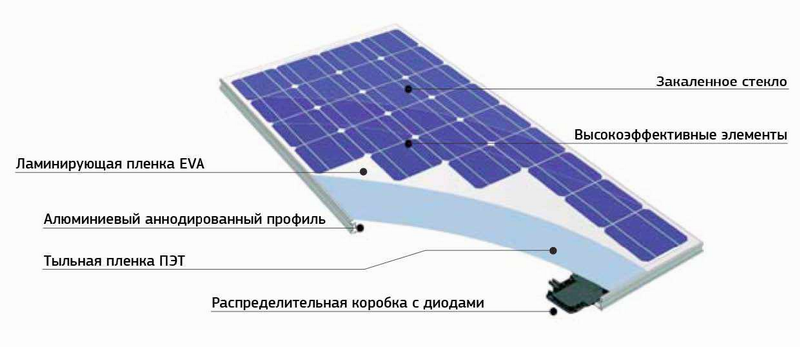
At first glance, all the solar panels are the same: the cells of the solar cells are interconnected by the shank, and on the back side there are two wires: plus and minus. But there are a lot of nuances in this business. Solar panels come from different elements: amorphous, polycrystalline, single-crystal. I will not agitate for this or that type of elements. Let me just say that I myself prefer monocrystalline solar panels. But that's not all. Each solar battery is a four-layer cake: glass, transparent EVA film, solar cell, sealing film. And here each stage is extremely important. Glass is not suitable for anyone, but with a special texture that reduces the reflection of light and refracts the incident light at an angle so that the elements are as lit as possible, because the amount of energy depends on the amount of light. The transparency of the EVA film determines how much energy is transferred to the element and how much energy the panel will generate. If the film turns out to be defective and dims with time, then the output will drop significantly.
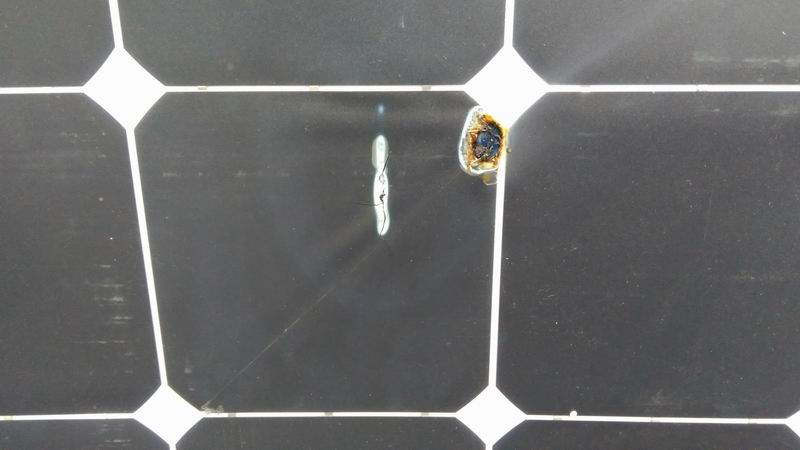
Next come the elements themselves, and they are distributed by type, depending on quality: Grade A, B, C, D and on. Of course, it is better to have elements of quality A and good soldering, because with poor contact, the element will warm up and fail faster. Well, the finishing film should also be of high quality and provide good sealing. In case of depressurization of the panels, very quickly moisture gets onto the elements, corrosion will start and the panel will also fail.
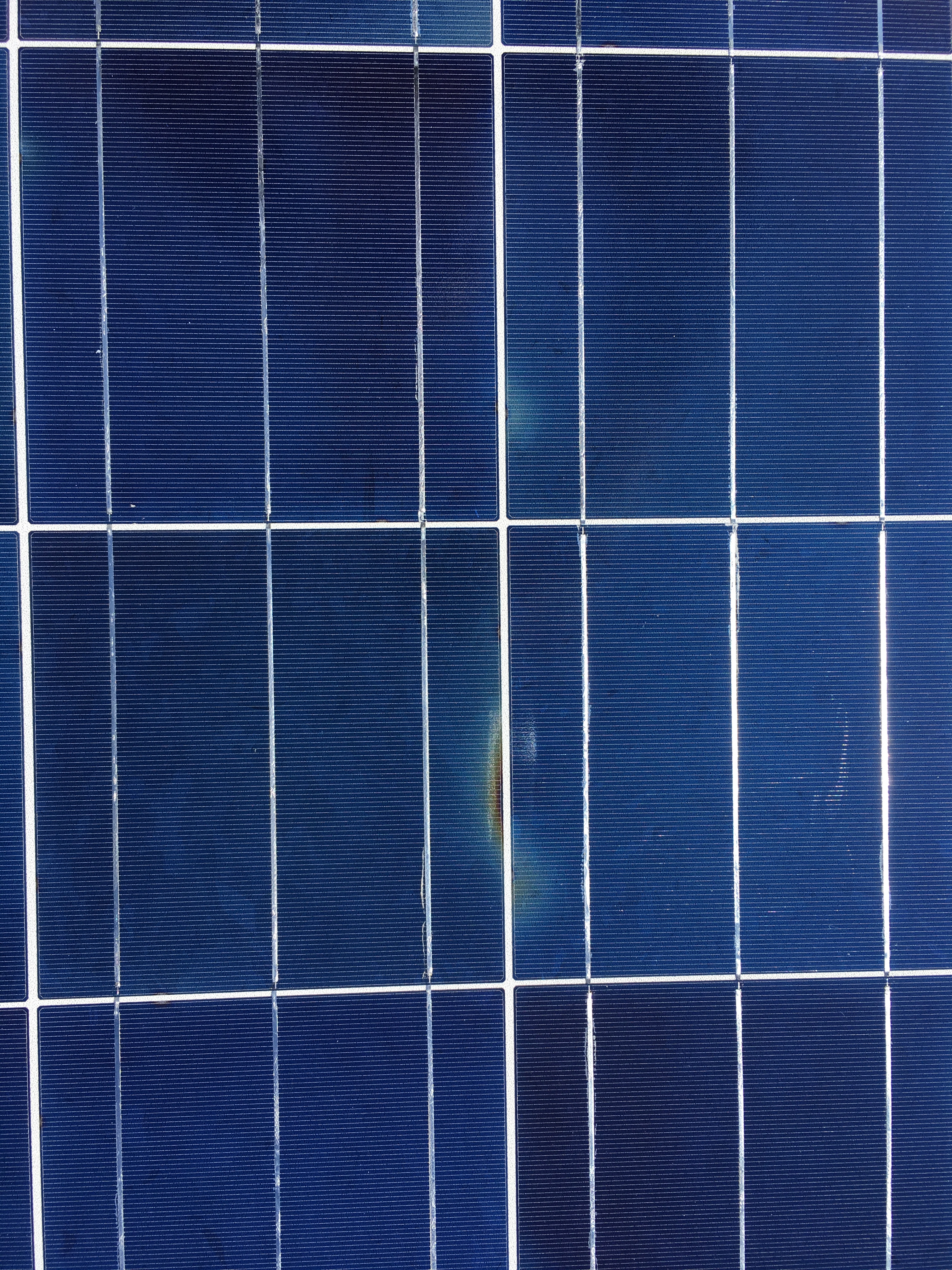
How to choose a solar panel? The main producer for our country is China, although Russian manufacturers are also present on the market. There are lots of OEMs that will stick any label ordered and send the panels to the customer. And there are factories that provide a full production cycle and are able to control the quality of products at all stages of production. How to learn about such factories and brands? There are a couple of reputable laboratories that conduct independent tests of solar panels and openly publish the results of these tests. Before buying, you can drive in the name and model of the solar panel and find out how the solar panel meets the stated specifications. The first laboratory is the California Energy Commission , and the second European laboratory is the TUV . If the manufacturer of the panels in these lists is not, then you should think about the quality. This does not mean that the panel is bad. Just a brand can be an OEM, and the manufacturing plant produces other panels. In any case, the presence in the lists of these laboratories already indicates that you do not buy solar batteries from a one-day manufacturer.
Before buying, it is worthwhile to outline the range of tasks that are put in front of a solar power station, in order not to pay for the unnecessary and not to overpay for the unused. Here I will move on to practice, as I did myself. For a start, the goal and the source: in the village periodically turn off the electricity for a period of half an hour to 8 hours. Possible shutdowns once a month, and several days in a row. Objective: to provide the house with electricity supply around the clock with some restriction of consumption for the period of shutdown of the external network. At the same time, the main security and life support systems must function, that is: the pumping station, the video surveillance and alarm system, the router, the server and the entire network infrastructure, lighting and computers, and the refrigerator must work. Secondary: TVs, entertainment systems, power tools (lawn mower, trimmer, pump for watering the garden). It is possible to turn off: a boiler, an electric kettle, an iron, and other heating devices that consume a lot of energy, and their operation is not immediately important. Kettle can be boiled on a gas stove, and pat later.
As a rule, the solar power station can be bought in one place. The solar panel vendors also sell all the related equipment, so I began searching for the solar panels. One of the major brands is TopRay Solar. About them there are good reviews and real operating experience in Russia, in particular, in the Krasnodar Territory, where they know a lot about the sun. In the Russian Federation there is an official distributor and dealers in the regions, on the above mentioned sites with laboratories for testing solar panels this brand is present and far from the last places, that is, you can take. In addition, the company-seller of solar panels TopRay, also engaged in its own production of controllers and electronics for road infrastructure: traffic management systems, LED traffic lights, flashing signs, solar controllers, and more. For the sake of curiosity, he even asked for their production - quite technologically and even there are girls who know which side to approach the soldering iron. Happens!
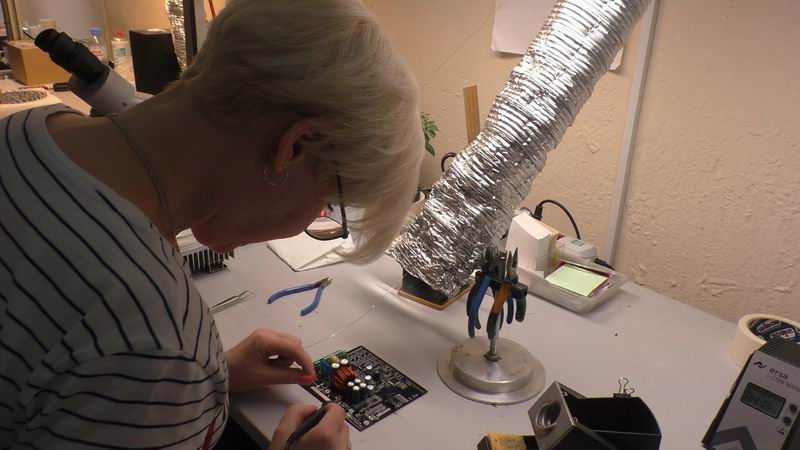

With my list of hotelok, I turned to them and asked me to collect a couple of complete sets: more expensive and cheaper for my house. I was asked a series of clarifying questions about the reserved power, the presence of consumers, the maximum and constant power consumption. The last thing turned out to be unexpected for me: the house in the power saving mode, when only video surveillance, security systems, Internet connection and network infrastructure work, consumes 300-350 W. That is, even if no one uses electricity at home, domestic needs take up to 215 kWh per month. This is where you think about conducting an energy audit. And you start turning off the charging outlets, TVs and set-top boxes, which consume a little bit in the standby mode, but run in decently.
I will not torment, I stopped on a cheaper system, as often up to half the amount for a power plant can be the cost of batteries. The list of equipment was as follows:
Additionally, I was asked to purchase a professional system of mounting solar panels on the roof, but I, after looking at the photos, decided to do with homemade mounts and also save money. But I decided to build the system myself and did not spare the time and effort, and the installers work with these systems constantly and guarantee fast and high-quality results. So decide for yourself: it is much more pleasant and easier to work with factory fixtures, and my solution is simply cheaper.
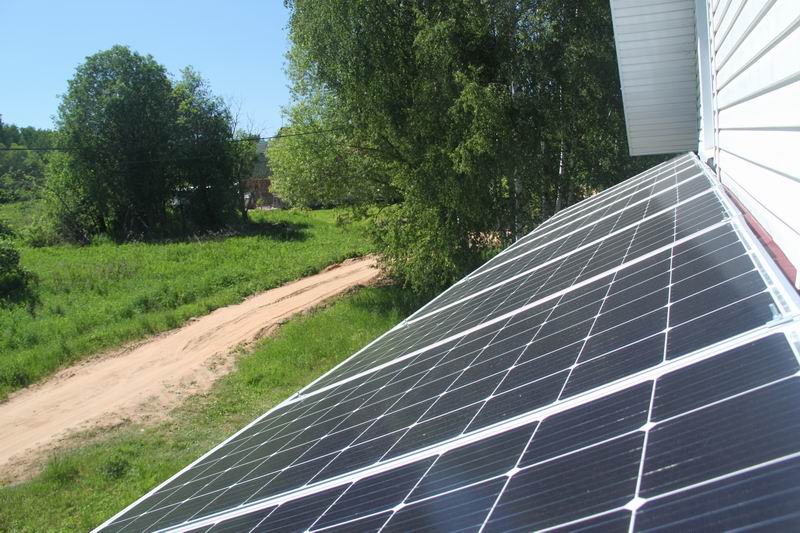
This kit can deliver up to 5 kW of power in autonomous mode - it is this power that I chose a single-phase inverter. If you buy the same inverter and interface module to it, then you can increase the power to 5 kW + 5 kW = 10 kW per phase. Or you can make a three-phase system, but for now I'm content with this. The inverter is high-frequency, and therefore light enough (about 15 kg) and takes up little space - it is easily mounted on the wall. It already has 2 MPPT-controllers with a capacity of 2.5 kW each, that is, I can add as many panels without buying additional equipment.
I have 2520 watts of solar panels on the nameplate, but because of the non-optimal installation angle, they give out less - I saw a maximum of 2400 watts. The optimal angle is perpendicular to the sun, which in our latitudes is approximately 45 degrees to the horizon. My panels are set at 30 degrees.
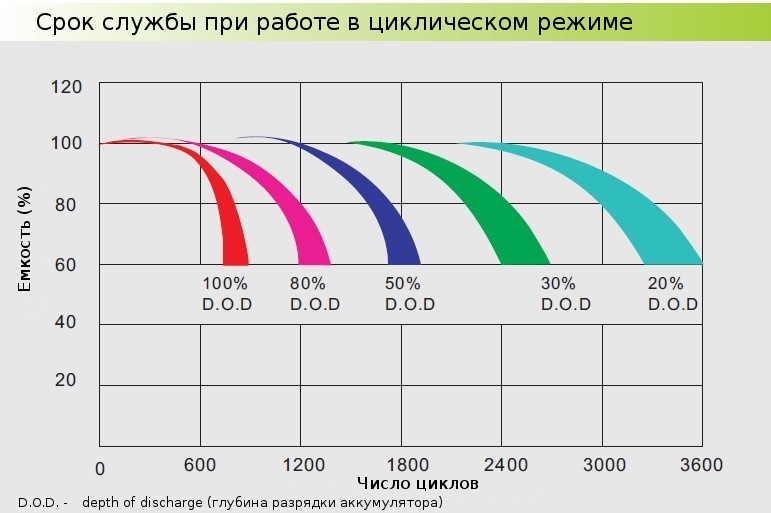
The battery assembly is 100A * h 48V, that is, 4.8 kW * h is stored, but it is completely undesirable to take energy, because then their resource is noticeably reduced. It is advisable to discharge such batteries no more than 50%. This lithium-iron phosphate or lithium-titanate can be charged and discharged with deep and large currents, and lead-acid, be it liquid, gel or AGM, it is better not to force. So, I have half the capacity, which is 2.4 kWh, that is, about 8 hours in a completely autonomous mode without the sun. This is enough for the night of work of all systems and half the battery capacity remains in emergency mode. In the morning, the sun will already rise and start charging the battery, while simultaneously providing the house with energy. That is, the house can function autonomously in this mode, if energy consumption is reduced and the weather is good. For complete autonomy, you could add more batteries and a generator. After all, in the winter the sun is very small and will not do without a generator.
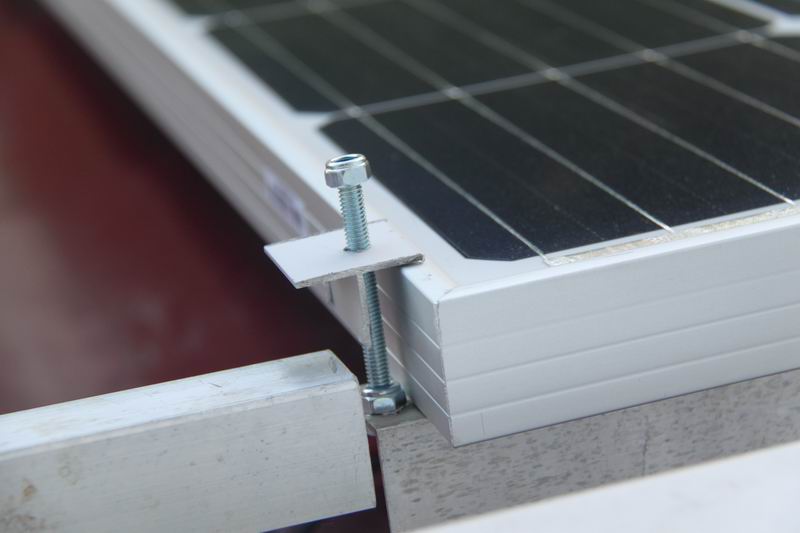
Before purchasing and assembling, it is necessary to calculate the entire system in order not to be mistaken with the location of all systems and the laying of cables. From solar panels to an inverter, I have about 25-30 meters and I laid two flexible wires in advance with a cross section of 6 sq. Mm, as the voltage up to 100V and current 25-30A will be transmitted through them. This margin over the cross section was chosen to minimize losses on the wire and to deliver the maximum energy to the devices. I mounted the solar panels on self-made rails from aluminum corners and attracted them with self-made fixings. To prevent the panel from sliding down, on the aluminum corner in front of each panel a pair of 30mm bolts is looking up, and they are a kind of hook for the panels. After installation, they are not visible, but they continue to bear the load.

The solar panels were assembled in three blocks of 3 panels each. In the panels, the panels are connected in series - so it was possible to raise the voltage to 115V without a load and reduce the current, which means you can choose wires of a smaller section. The blocks are connected in parallel with special connectors that provide good contact and tight connection - called MC4. I used them to connect the wires to the solar controller, as they provide reliable contact and quick circuit / opening of the circuit for maintenance.

Next, go to the installation in the house. The batteries are precharged by smart car charging to equalize the voltage and connected in series to provide 48V. Further, they are connected to the inverter with a cable with a cross section of 25 mm square. By the way, during the first connection of the battery to the inverter there will be a noticeable spark on the contacts. If you do not confuse the polarity, then everything is fine - rather capacious capacitors are installed in the inverter and they start charging at the time of connection to the batteries. The maximum power of the inverter is 5000 W, which means the current that can flow through the wire from the battery will be 100-110A. Selected cable is sufficient for safe operation. After connecting the battery, you can connect the external network and the load at home. To terminal blocks cling wires: phase, zero, ground. Everything is simple and clear, but if it is not safe to repair the outlet for you, then it is better to entrust the connection of this system to experienced electricians. Well, the last element I connect the solar panels: here, too, you need to be careful and not to confuse the polarity. With a power of 2.5 kW and improper connection, the solar controller will burn instantly. What can I say: with such power, from solar panels you can do welding directly, without a welding inverter. Health is not add solar panels, but the power of the sun is really great. Since I additionally use MC4 connectors, it is simply impossible to confuse the polarity with the initial proper installation.
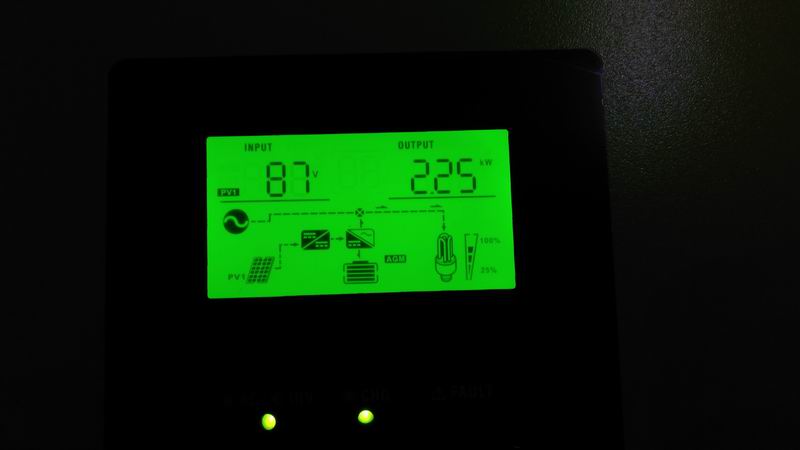
Everything is connected, one click of the switch and the inverter enters the setup mode: here you have to set the battery type, operating mode, charging currents and so on. There is quite a clear instruction for this, and if you can cope with setting up the router, then setting up the inverter will also not be very difficult. It is only necessary to know the parameters of the battery and properly configure them so that they serve as long as possible. After that, hmm ... After that, the most interesting comes.
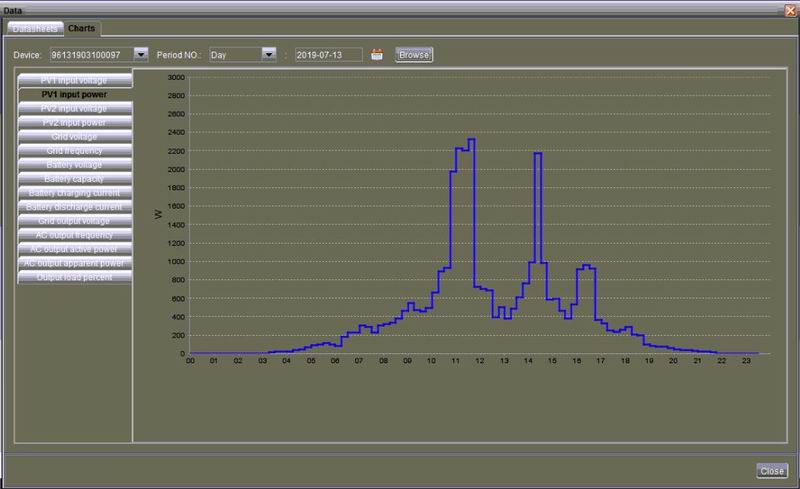
After starting the solar power station, my family and I revised many habits. For example, if earlier a wash or a dishwasher was started after 23 hours, when the night tariff was working in electrical networks, now these energy-intensive works are postponed for a day, because the washer consumes 500-2100 watts during operation, the dishwasher consumes 400-2100 watts. Why such a scatter? Because pumps and motors consume little, but water heaters are extremely voracious. Ironing turned out to be also “more profitable” and more pleasant during the day: the room is much lighter, and the sun's energy completely covers the consumption of the iron. The screenshot shows the energy production schedule of the solar power plant. The morning peak is clearly visible when the washing machine was working and consuming a lot of energy - this energy was generated by solar panels.
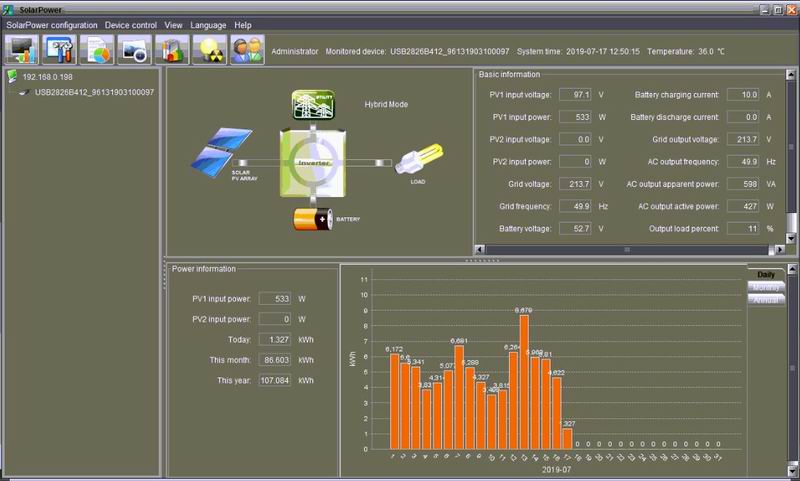
The first days I approached the inverter several times, to look at the screen of production and consumption. After putting the utility on the home server, which in real time displays the mode of operation of the inverter and all the parameters of the power supply. For example, in the screenshot it can be seen that the house consumes more than 2 kW of energy (AC output active power) and all this energy is borrowed from solar panels (PV1 input power). That is, the inverter, working in a hybrid mode with a priority of power from the sun, completely covers the power consumption of devices at the expense of the sun. Is this not happiness? Every day a new energy generation column appeared in the table and this could not but rejoice. And when electricity was cut off in the whole village, I learned about it only from the squeak of the inverter, which reported on the work in offline mode. For the whole house, this meant only one thing: we live as before, while neighbors go for water with buckets.
But there are in the presence of a home solar power station and the nuances:
Not to say that these points somehow upset, because you always have to strive for perfection, but the existing energy independence is worth it.
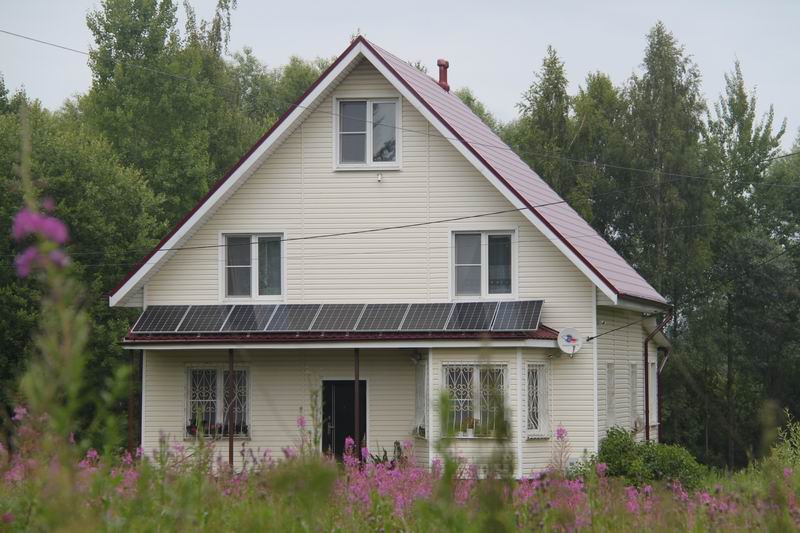
I believe that this is not my last story about my own solar power station. Operating experience in different modes and at different times of the year will definitely be different, but I know for sure that even if the electricity is cut off in the New Year, it will be light in my house. According to the results of operation of the installed solar power station, I can say that it was worth it. Several outages of the external network went unnoticed. I found out about a few only after calls from my neighbors asking “Do you also have no light?”. The running electricity generation figures are immensely gratifying, and the ability to remove UPS from the computer, knowing that even with a power outage, everything will continue to work, is pleasant. Well, when we finally have a law on the possibility of selling electricity by individuals to the grid, I’ll be the first to apply for this function,After all, in the inverter it is enough to change one point and all the energy developed, but not consumed by the house, I will sell to the network and get money for it. In general, it was quite simple, efficient and convenient. I am ready to answer your questions and withstand the onslaught of critics, who convince everyone that in our latitudes a solar power station is a toy.
Baseline: a private house with an area of about 200 m2 is connected to the grid. Three-phase input, with a total power of 15 kW. The house has a standard set of electrical appliances: refrigerator, televisions, computers, washing and dishwashers, and so on. The stability of the power grid is no different: the record I recorded was a shutdown of 6 days in a row for a period of 2 to 8 hours.
What I want to get: forget about the power outages and use electricity, no matter what.
')
What bonuses can be: Make the most of the sun's energy, so that the house prioritizes on solar energy, and the shortage gets from the network. As a bonus, after the adoption of the law on the sale of electricity by individuals to the network, begin to offset part of their costs by selling surplus generation to the general electricity grid.
Where to begin?
There are always at least two ways to solve any problem: to learn by yourself or to entrust the solution of a problem to someone else. The first option involves the study of theoretical materials, reading forums, communication with the owners of solar power plants, the fight against internal toad and, finally, the purchase of equipment, and after - installation. The second option is to call a specialized company, where they will ask many questions, pick up and sell the necessary equipment, or they can install it for some money. I decided to combine these two ways. Partly because it is interesting to me, and partly in order not to run into sellers who just need to earn money by selling not exactly what I need. Now it's time for a theory to understand how I made the choice.

In the photo is an example of the "development" of money for the construction of a solar power station. Notice that the solar panels are installed behind the tree - thus, the light does not fall on them, and they simply do not work.
Types of solar power plants

Immediately, I will say that I will not talk about industrial solutions and not about super-power systems, but about the usual consumer solar power plant for a small house. I am not an oligarch to waste money, but I adhere to the principle of reasonableness. That is, I don’t want to heat the pool with “solar” electricity or charge an electric car, which I don’t have, but I want all the appliances in my house to work constantly, without looking at the electrical network.
Now I will tell about the types of solar power plants for a private house. By and large, there are only three of them, but there are variations. I will be located on the growth of the cost of each system.
Network Solar Power Station - this type of power plant combines low cost and maximum ease of operation. It consists of only two elements: solar panels and a power inverter. Electricity from solar panels is directly converted to 220V / 380V in the house and consumed by household energy systems. But there is a significant drawback: the backbone network is necessary for the operation of the SSE. In case of disconnection of the external power supply network, the solar panels will turn into a “pumpkin” and cease to generate electricity, since for the operation of the mains inverter, the reference network is needed, that is, the very presence of electricity. In addition, with the existing power grid infrastructure, the operation of a power inverter is not very profitable. Example: you have a solar power station of 3 kW, and the house consumes 1 kW. The surplus will “flow” into the network, and conventional meters consider energy “by module”, that is, the meter delivered to the network will calculate how consumed, and you still have to pay for it. Here the logical question is: where to put the extra energy and how to avoid it? We turn to the second type of solar power plants.
Hybrid Solar Power Station - this type of power plant combines the advantages of a networked and autonomous power station. It consists of 4 elements: solar panels, solar controller, batteries and a hybrid inverter. The basis of everything is a hybrid inverter, which is capable of mixing energy from solar panels into the energy consumed from an external network. Moreover, good inverters have the ability to customize the prioritization of energy consumed. Ideally, the house should first consume energy from solar panels and only with its lack, get from the external network. In the event of the disappearance of the external network, the inverter goes into autonomous operation and uses the energy from solar panels and the energy stored in the batteries. Thus, even if the electricity is disconnected for a long time and it is a cloudy day (or the electricity is disconnected at night), everything in the house will function. But what to do if there is no electricity at all, but somehow you have to live? Here I turn to the third type of power station.
Autonomous Solar Power Station - this type of power plant allows you to live completely independently of external power grids. It may include more than 4 standard elements: solar panels, solar controller, battery, inverter.
In addition to this, and sometimes instead of solar panels, a Hydropower Plant of low power, a wind power plant, or a generator (diesel, gas or petrol) can be installed. As a rule, there is a generator at such facilities, since there may be no sun and wind, and the energy supply in the batteries is not infinite - in this case, the generator starts and provides energy to the whole object, simultaneously charging the battery. Such a power plant is easily transformed into a hybrid one, when an external power supply is connected, if the inverter has these functions. The main difference between an autonomous inverter and a hybrid one is that it does not know how to mix energy from solar panels to energy from an external network. At the same time, the hybrid inverter, on the contrary, can work as a stand-alone one if the external network is disconnected. As a rule, hybrid inverters are commensurate in price with fully autonomous, and if they are different, then they are insignificant.
What is a solar controller?

In all types of solar power plants there is a solar controller. Even in the network of solar power it is, just part of the network inverter. Yes, and many hybrid inverters are available with solar controllers on board. What is it and what is it for? I will talk about a hybrid and autonomous solar power station, since this is just my case, and I can familiarize myself with the network inverter device in the comments if there are requests in the comments.
The solar controller is a device that converts the energy received from solar panels into energy that is digested by the inverter. For example, solar panels are manufactured with a voltage of a multiple of 12V. And batteries are made in multiples of 12V, so it has become a tradition. Simple 1-2 kW power systems operate on 12V. 2-3 kW productive systems are already functioning from 24V, and powerful systems of 4-5 kW and more operate on 48V. Now I will consider only "home" systems, because I know that there are inverters operating at voltages of several hundred volts, but for the house it is already dangerous.
So, let's say we have a 48V system and 36V solar panels (the panel is assembled in multiples of 3x12V). How to get the required 48V for the inverter? Of course, a 48V battery is connected to the inverter, and a solar controller is connected to these batteries on one side and solar panels on the other. Solar panels are going to deliberately more voltage to be able to charge the battery. The solar controller, receiving a deliberately greater voltage from the solar panels, transforms this voltage to the desired value and transmits it to the battery. It is oversimplified. There are controllers that can reduce from 150-200 V from solar panels to 12 V batteries, but here very large currents flow and the controller works with worse efficiency. The ideal case, when the voltage from the solar panels is twice the voltage on the battery.
There are two types of solar controllers: PWM (PWM - Pulse Width Modulation) and MPPT (Maximum Power Point Tracking). The principal difference between them is that the PWM controller can only work with panel assemblies that do not exceed the battery voltage. MPPT - the controller can operate with a noticeable overvoltage relative to the battery. In addition, MPPT controllers have significantly greater efficiency, but also cost more.
How to choose a solar panel?

At first glance, all the solar panels are the same: the cells of the solar cells are interconnected by the shank, and on the back side there are two wires: plus and minus. But there are a lot of nuances in this business. Solar panels come from different elements: amorphous, polycrystalline, single-crystal. I will not agitate for this or that type of elements. Let me just say that I myself prefer monocrystalline solar panels. But that's not all. Each solar battery is a four-layer cake: glass, transparent EVA film, solar cell, sealing film. And here each stage is extremely important. Glass is not suitable for anyone, but with a special texture that reduces the reflection of light and refracts the incident light at an angle so that the elements are as lit as possible, because the amount of energy depends on the amount of light. The transparency of the EVA film determines how much energy is transferred to the element and how much energy the panel will generate. If the film turns out to be defective and dims with time, then the output will drop significantly.

Next come the elements themselves, and they are distributed by type, depending on quality: Grade A, B, C, D and on. Of course, it is better to have elements of quality A and good soldering, because with poor contact, the element will warm up and fail faster. Well, the finishing film should also be of high quality and provide good sealing. In case of depressurization of the panels, very quickly moisture gets onto the elements, corrosion will start and the panel will also fail.

How to choose a solar panel? The main producer for our country is China, although Russian manufacturers are also present on the market. There are lots of OEMs that will stick any label ordered and send the panels to the customer. And there are factories that provide a full production cycle and are able to control the quality of products at all stages of production. How to learn about such factories and brands? There are a couple of reputable laboratories that conduct independent tests of solar panels and openly publish the results of these tests. Before buying, you can drive in the name and model of the solar panel and find out how the solar panel meets the stated specifications. The first laboratory is the California Energy Commission , and the second European laboratory is the TUV . If the manufacturer of the panels in these lists is not, then you should think about the quality. This does not mean that the panel is bad. Just a brand can be an OEM, and the manufacturing plant produces other panels. In any case, the presence in the lists of these laboratories already indicates that you do not buy solar batteries from a one-day manufacturer.
My choice of solar power station
Before buying, it is worthwhile to outline the range of tasks that are put in front of a solar power station, in order not to pay for the unnecessary and not to overpay for the unused. Here I will move on to practice, as I did myself. For a start, the goal and the source: in the village periodically turn off the electricity for a period of half an hour to 8 hours. Possible shutdowns once a month, and several days in a row. Objective: to provide the house with electricity supply around the clock with some restriction of consumption for the period of shutdown of the external network. At the same time, the main security and life support systems must function, that is: the pumping station, the video surveillance and alarm system, the router, the server and the entire network infrastructure, lighting and computers, and the refrigerator must work. Secondary: TVs, entertainment systems, power tools (lawn mower, trimmer, pump for watering the garden). It is possible to turn off: a boiler, an electric kettle, an iron, and other heating devices that consume a lot of energy, and their operation is not immediately important. Kettle can be boiled on a gas stove, and pat later.
As a rule, the solar power station can be bought in one place. The solar panel vendors also sell all the related equipment, so I began searching for the solar panels. One of the major brands is TopRay Solar. About them there are good reviews and real operating experience in Russia, in particular, in the Krasnodar Territory, where they know a lot about the sun. In the Russian Federation there is an official distributor and dealers in the regions, on the above mentioned sites with laboratories for testing solar panels this brand is present and far from the last places, that is, you can take. In addition, the company-seller of solar panels TopRay, also engaged in its own production of controllers and electronics for road infrastructure: traffic management systems, LED traffic lights, flashing signs, solar controllers, and more. For the sake of curiosity, he even asked for their production - quite technologically and even there are girls who know which side to approach the soldering iron. Happens!


With my list of hotelok, I turned to them and asked me to collect a couple of complete sets: more expensive and cheaper for my house. I was asked a series of clarifying questions about the reserved power, the presence of consumers, the maximum and constant power consumption. The last thing turned out to be unexpected for me: the house in the power saving mode, when only video surveillance, security systems, Internet connection and network infrastructure work, consumes 300-350 W. That is, even if no one uses electricity at home, domestic needs take up to 215 kWh per month. This is where you think about conducting an energy audit. And you start turning off the charging outlets, TVs and set-top boxes, which consume a little bit in the standby mode, but run in decently.
I will not torment, I stopped on a cheaper system, as often up to half the amount for a power plant can be the cost of batteries. The list of equipment was as follows:
- Solar battery TopRay Solar 280 W Mono - 9 pcs
- Single Phase InfiniSolar V-5K-48 5 kW Hybrid Inverter - 1 pc
- Battery AGM Sail HML-12-100 - 4 pcs
Additionally, I was asked to purchase a professional system of mounting solar panels on the roof, but I, after looking at the photos, decided to do with homemade mounts and also save money. But I decided to build the system myself and did not spare the time and effort, and the installers work with these systems constantly and guarantee fast and high-quality results. So decide for yourself: it is much more pleasant and easier to work with factory fixtures, and my solution is simply cheaper.
What does a solar power plant do?

This kit can deliver up to 5 kW of power in autonomous mode - it is this power that I chose a single-phase inverter. If you buy the same inverter and interface module to it, then you can increase the power to 5 kW + 5 kW = 10 kW per phase. Or you can make a three-phase system, but for now I'm content with this. The inverter is high-frequency, and therefore light enough (about 15 kg) and takes up little space - it is easily mounted on the wall. It already has 2 MPPT-controllers with a capacity of 2.5 kW each, that is, I can add as many panels without buying additional equipment.
I have 2520 watts of solar panels on the nameplate, but because of the non-optimal installation angle, they give out less - I saw a maximum of 2400 watts. The optimal angle is perpendicular to the sun, which in our latitudes is approximately 45 degrees to the horizon. My panels are set at 30 degrees.

The battery assembly is 100A * h 48V, that is, 4.8 kW * h is stored, but it is completely undesirable to take energy, because then their resource is noticeably reduced. It is advisable to discharge such batteries no more than 50%. This lithium-iron phosphate or lithium-titanate can be charged and discharged with deep and large currents, and lead-acid, be it liquid, gel or AGM, it is better not to force. So, I have half the capacity, which is 2.4 kWh, that is, about 8 hours in a completely autonomous mode without the sun. This is enough for the night of work of all systems and half the battery capacity remains in emergency mode. In the morning, the sun will already rise and start charging the battery, while simultaneously providing the house with energy. That is, the house can function autonomously in this mode, if energy consumption is reduced and the weather is good. For complete autonomy, you could add more batteries and a generator. After all, in the winter the sun is very small and will not do without a generator.
Starting to collect

Before purchasing and assembling, it is necessary to calculate the entire system in order not to be mistaken with the location of all systems and the laying of cables. From solar panels to an inverter, I have about 25-30 meters and I laid two flexible wires in advance with a cross section of 6 sq. Mm, as the voltage up to 100V and current 25-30A will be transmitted through them. This margin over the cross section was chosen to minimize losses on the wire and to deliver the maximum energy to the devices. I mounted the solar panels on self-made rails from aluminum corners and attracted them with self-made fixings. To prevent the panel from sliding down, on the aluminum corner in front of each panel a pair of 30mm bolts is looking up, and they are a kind of hook for the panels. After installation, they are not visible, but they continue to bear the load.

The solar panels were assembled in three blocks of 3 panels each. In the panels, the panels are connected in series - so it was possible to raise the voltage to 115V without a load and reduce the current, which means you can choose wires of a smaller section. The blocks are connected in parallel with special connectors that provide good contact and tight connection - called MC4. I used them to connect the wires to the solar controller, as they provide reliable contact and quick circuit / opening of the circuit for maintenance.

Next, go to the installation in the house. The batteries are precharged by smart car charging to equalize the voltage and connected in series to provide 48V. Further, they are connected to the inverter with a cable with a cross section of 25 mm square. By the way, during the first connection of the battery to the inverter there will be a noticeable spark on the contacts. If you do not confuse the polarity, then everything is fine - rather capacious capacitors are installed in the inverter and they start charging at the time of connection to the batteries. The maximum power of the inverter is 5000 W, which means the current that can flow through the wire from the battery will be 100-110A. Selected cable is sufficient for safe operation. After connecting the battery, you can connect the external network and the load at home. To terminal blocks cling wires: phase, zero, ground. Everything is simple and clear, but if it is not safe to repair the outlet for you, then it is better to entrust the connection of this system to experienced electricians. Well, the last element I connect the solar panels: here, too, you need to be careful and not to confuse the polarity. With a power of 2.5 kW and improper connection, the solar controller will burn instantly. What can I say: with such power, from solar panels you can do welding directly, without a welding inverter. Health is not add solar panels, but the power of the sun is really great. Since I additionally use MC4 connectors, it is simply impossible to confuse the polarity with the initial proper installation.

Everything is connected, one click of the switch and the inverter enters the setup mode: here you have to set the battery type, operating mode, charging currents and so on. There is quite a clear instruction for this, and if you can cope with setting up the router, then setting up the inverter will also not be very difficult. It is only necessary to know the parameters of the battery and properly configure them so that they serve as long as possible. After that, hmm ... After that, the most interesting comes.
Operation of a hybrid solar power plant

After starting the solar power station, my family and I revised many habits. For example, if earlier a wash or a dishwasher was started after 23 hours, when the night tariff was working in electrical networks, now these energy-intensive works are postponed for a day, because the washer consumes 500-2100 watts during operation, the dishwasher consumes 400-2100 watts. Why such a scatter? Because pumps and motors consume little, but water heaters are extremely voracious. Ironing turned out to be also “more profitable” and more pleasant during the day: the room is much lighter, and the sun's energy completely covers the consumption of the iron. The screenshot shows the energy production schedule of the solar power plant. The morning peak is clearly visible when the washing machine was working and consuming a lot of energy - this energy was generated by solar panels.

The first days I approached the inverter several times, to look at the screen of production and consumption. After putting the utility on the home server, which in real time displays the mode of operation of the inverter and all the parameters of the power supply. For example, in the screenshot it can be seen that the house consumes more than 2 kW of energy (AC output active power) and all this energy is borrowed from solar panels (PV1 input power). That is, the inverter, working in a hybrid mode with a priority of power from the sun, completely covers the power consumption of devices at the expense of the sun. Is this not happiness? Every day a new energy generation column appeared in the table and this could not but rejoice. And when electricity was cut off in the whole village, I learned about it only from the squeak of the inverter, which reported on the work in offline mode. For the whole house, this meant only one thing: we live as before, while neighbors go for water with buckets.
But there are in the presence of a home solar power station and the nuances:
- I began to notice that birds love solar panels and, flying over them, cannot restrain from the happiness of having technological equipment in the village. That is, sometimes all the same solar panels need to be cleaned from traces and dust. I think that when installed at 45 degrees, all traces would simply be washed away by rain. Production from a few bird tracks does not fall at all, but if part of the panel is shaded, then the drop in development becomes noticeable. This I noticed when the sun began to set and the shade from the roof began to cover the panels one by one. That is, it is better to place the panels away from all structures that can shade them. But even in the evening, with diffused light, the panels gave out a few hundred watts.
- With a high power of solar panels and pumping from 700 watts and more, the inverter turns on the fans more actively and they become audible if the door to the technical room is open. Here either close the door, or mount the inverter on the wall through the damping pads. In principle, nothing unexpected: any electronics is heated at work. Just keep in mind that the inverter should not be hung where it can interfere with the sound of its work.
- A proprietary application can send e-mail or SMS alerts if an event occurs: switching on / off an external network, discharging batteries, and the like. But the application works on an unprotected SMTP port 25, and all modern mail services, like gmail.com or mail.ru, work on a secure port 465. That is, now, in fact, no mail alerts come, but I would like to.
Not to say that these points somehow upset, because you always have to strive for perfection, but the existing energy independence is worth it.
Conclusion

I believe that this is not my last story about my own solar power station. Operating experience in different modes and at different times of the year will definitely be different, but I know for sure that even if the electricity is cut off in the New Year, it will be light in my house. According to the results of operation of the installed solar power station, I can say that it was worth it. Several outages of the external network went unnoticed. I found out about a few only after calls from my neighbors asking “Do you also have no light?”. The running electricity generation figures are immensely gratifying, and the ability to remove UPS from the computer, knowing that even with a power outage, everything will continue to work, is pleasant. Well, when we finally have a law on the possibility of selling electricity by individuals to the grid, I’ll be the first to apply for this function,After all, in the inverter it is enough to change one point and all the energy developed, but not consumed by the house, I will sell to the network and get money for it. In general, it was quite simple, efficient and convenient. I am ready to answer your questions and withstand the onslaught of critics, who convince everyone that in our latitudes a solar power station is a toy.
Source: https://habr.com/ru/post/460457/
All Articles